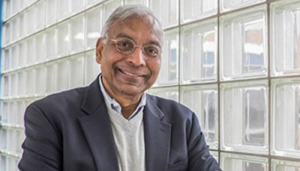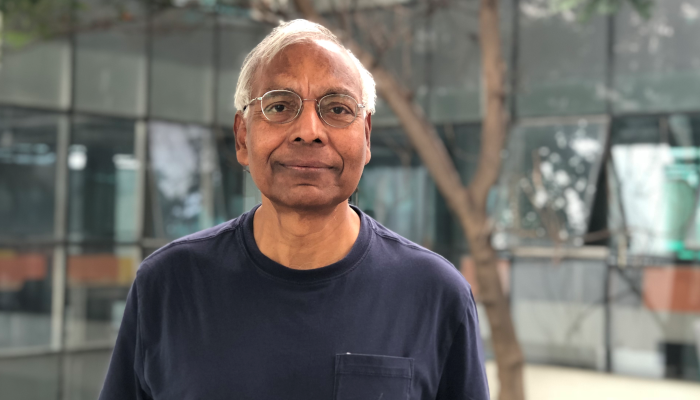Legend has it that he is on the speed dial of the Senate and other security agencies of the United States of America. A suggestion he dismisses with a laugh, saying he’s not *that* important, admitting though that he does have significant exposure to the Press. Like an interview scheduled with the Rolling Stones magazine later in the day, for his views on using facial recognition at rock concerts.
This professor with the highest h-index among all computer scientists is visiting IIIT-H for a month as part of the VAJRA (Visiting Advanced Joint Research) Faculty Scheme dedicated program exclusively for overseas scientists and academicians of NRI origin. He is known for his path-breaking innovations in the fields of pattern recognition, computer vision and biometrics. Meet renowned computer scientist and distinguished professor from Michigan State University, Prof. Anil Jain.

In an informal Q&A, Prof. Anil Jain shares his views on Aadhaar, loss of privacy, and his emphatic belief in the robustness of fingerprinting as a biometric. Tracing the beginning of biometrics to Biblical times, Prof. Anil Jain talks of how biometrics as we know it has evolved more recently – from its application in forensics and criminal investigations to civilian settings where it is maintained in nation-wide databases (like the Aadhaar) to its now ubiquitous use in smartphones as a securing measure.
How did your foray into specializing in Biometrics, especially biometric fingerprinting begin?
Over the past 50 years, I’ve been working in the field of pattern recognition which now goes by many different names – data mining, machine learning, artificial intelligence. The field of pattern recognition is a general field, and the goal essentially is that, given the environment around us, how do we recognize objects? And the objects could be trees, automobiles, people, cells or tissues in medical images and so on. Around 1990, I received a call from one of the agencies (National Security Agency) in Washington D.C, saying that they had built a new processor for intelligence operations – one of its kind, asking if we could create practical, civilian applications for it. The architecture revealed that it could do an analysis of images, both at the low level (where it can enhance the quality of the image) and the high level (where we can start recognizing some patterns in the images). While musing on where we could find data to do such an analysis, we stumbled upon the idea of using fingerprints! And that’s how our entry into the world of fingerprinting began. It was not intended to be a fingerprinting project. The goal then modified itself to: How can we do a faster processing of fingerprints using this special hardware compared to the general purpose processors available at the time. We had significant success in that. And at the time there were very few academic groups and researchers working in the area of fingerprints. Even now, there are not too many. And the reason is that there’s somehow a tendency to work on more exotic problems than some of the traditional ones which still don’t have solutions.
What are your plans during your stay at IIIT-H?
Aadhaar is the world’s largest biometric system – covering over 1.5 bn people. The largest database before Aadhaar was 100 bn and that was by the FBI. And unfortunately in India, the amount of technical expertise available in this area is limited. There are very few research institutes, IIIT-H being one of the most prominent among them, that has the strength to establish biometrics on their research agenda. With the establishment of the Biometric Research Lab here, we will be exploring how we can assist with some of the problems that Aadhaar is facing. The plan during my one-month stay here is to address some of the weaknesses of biometrics, quality being one – that is, how to build robust fingerprint and face recognition systems when the conditions under which they were acquired are not ideal. For example, inability to match fingerprints of a person whose fingers are calloused due to the type of manual labour he or she is involved in, damage to the fiction ridges caused due to the presence of chemicals and so on, or the inability to capture the iris due to an eye disease or infections or droopy eyelids. Second, how to detect if these systems themselves are attacked. Fingerprint spoofing can be done with something as simple as play doh. In our lab at MSU, we have a multi-million dollar project sponsored by the US Govt that can detect if the finger, face or iris that is presented in front of the camera is a real or a fake one. Research problems have been identified but they are dynamic in the sense that it is a mission-oriented research, which means that the agency’s priority may change over time. Despite the limitations of biometrics, it is the way to improve security, and has the ability to cut down fraud in social disbursements. It is far superior to the traditional security system of credentials and PIN or password.
Where do you think we are headed in terms of biometrics? What does the future look like?
(Laughs) In every place there’s going to be a biometric reader in some form or the other, where you can be tracked and your physical location known at any given moment. From opening doors automatically, to shopping at a grocery store, where they know what you’re buying and automatically deduct from your account, it will make life more convenient. There’ll no more be a need to carry devices or credit cards explicitly as long as you are recognized. Similarly at the airports. Currently gate agents at airports do not necessarily verify boarding cards. There is nothing to stop people from exchanging their boarding cards and boarding different flights. There’s a proposal to introduce fingerprint verification or facial recognition so that every passenger boarding a flight will have his or her biometric compared to the flight manifest so we know the right person has boarded the flight. While the number of applications is unlimited, there is a need to factor in the return on investment. Each time you install a biometric system, there’s a fixed cost and a recurring cost. For instance, ATM machines in the future could be based on biometrics, but the number of ATM machines installed run into hundreds of thousands. Banks incur losses when there are fraudulent transactions but compared to the cost of infrastructure change in installing new-age ATMs, the loss may pale in comparison. So every new application has to be assessed in terms of cost-benefit unless it is a Government initiative where there is an urgent need to empower people, especially the under-privileged as in the case of Aadhaar.
You mentioned ‘being followed and tracked’ in the future. What are your views on privacy?
There is a big concern about privacy, about how all this information could be misused. The SC judgement on Aadhaar has tried to address some of these issues. For instance, the SC says that Aadhaar authentication data for every transaction that you make like getting a cylinder refill or any other social benefit, is to be stored for only 6 months as opposed to the earlier 2 years. One has to have some laws and regulations governing it. Of course, it doesn’t mean they will not be violated but definitely penalties need to be associated with it. There are issues associated with privacy which are thorny but in the end the tradeoff is between security and privacy.
What is your take on the recent SC verdict on Aadhaar itself?
Well, I think it was a smart decision and the reservations that the SC made had to do with privacy. The original intent of Aadhaar was primarily for social disbursement and empowering people. But it started getting linked to opening a bank account or obtaining a mobile phone, and that was outside the original charter. By keeping the basic fundamentals of Aadhaar and giving validity to that is a smart thing. Because, without the Aadhaar, we will go back to the centuries-old system where people were marginalized. Any person can now produce the 12-digit unique number and be entitled to certain basic services. I was consulted during the early days of Aadhaar and there were concerns then about whether incentives had to be provided to get people to enroll for Aadhaar, but people turned out in large numbers standing in line at the first enrollment centre! It has definitely shown to be of good value.
You’ve been known to be a visionary. How do you foresee problems and pioneer research in those fields?!
That’s true. We have to find a space that is less crowded. We have to be aware of what others are doing. There’s no point in me going head-on with very established groups working on the same problems for over 20 years. So, yes, I have to find my own space where others have not gone in for whatever reason. And that requires some thinking, and some luck – talking to the right people..That’s why we have very good relations with the biometric companies, biometric governmental agencies and so on. A lot of these research agencies support our research. While they don’t pose any restrictions on publication of papers, they want us to focus on some specific issues which are of serious concern to them. In my lab at MSU, we work on problems, deliver solutions and in many cases these are then commercialized. For us the challenge as an academic researcher is that we always have to stay a step ahead of industry if we want the industry to take notice of our solutions and put it to practice.
Are you working on anything novel currently?
Yes, like spoof detection. People have worked on it before but not at this scale. People always take different materials and build different types of spoofs. So we have 14-15 different type of fingerprint spoofs using different materials. So in the sense, we have to stay one step ahead of the criminals. Of course, it doesn’t mean we always stay ahead but we try to! We are also addressing through the FBI some fundamental issues. One of the new projects funded by FBI deals with how we fuse different biometric modalities to improve overall biometrics just like what Aadhaar is doing, using both fingerprint and iris for deduplication.
This is not your first visit to the City of Pearls. What are your impressions of Hyderabad in general and IIIT-H in particular?
I came to Hyderabad for the first time in 1984. Since then it has changed a lot. Gachibowli was uninhabited then. The only thing present then was the CMC building where I used to come often. There was nothing at that time! Hyderabad has a huge culture. But it’s difficult to move around! (Laughs). IIIT-H is one of the first institutions of its kind focussed solely on information technology. In my opinion, this is one of the strongest educational institutions in India in Computer Science, especially Computer Vision. I like this institution and hence I chose this one in terms of focusing on biometric research.

Prof Jain will be delivering a KCIS Distinguished Talk on Fingerprints: 75 Billion-Class Recognition Problem on 23 October at 4pm. Register for the talk at http://bit.ly/KCISTalk



Next post